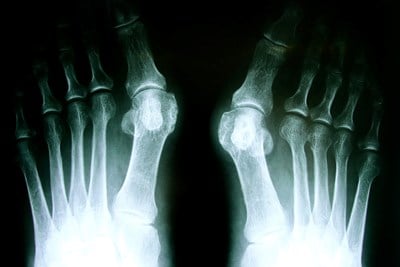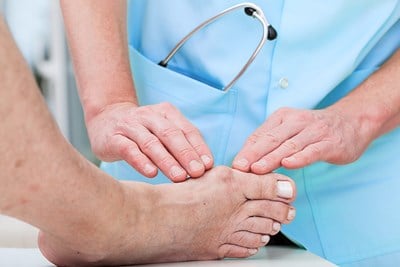Bunions can be an extremely painful condition, especially if you spend a lot of time on your feet. They form when the big toe is forced lean in toward the rest of the toes—eventually angling out. A bump of bone develops; often the skin will be red, calloused, and sore. Here is a look at how to help bunion pain and other symptoms.
Footwear
Sometimes, a change of shoes might help your pain. Wearing shoes that are too tight is commonly thought to be a cause of bunions—and bunions are more common in women, perhaps because female shoes tend to have pointier, tighter toes. Regardless, wearing shoes that are designed more widely may provide at least some relief, even if it doesn’t necessarily fix the problem. Stay away from stilettos, as well—keep heels below 2.25 inches if you have a bunion.
If you’ve already been wearing comfy shoes that aren’t narrow or excessively pointed, you might look into orthotic inserts as an alternative. Insoles are easily accessible, but it’s important to get the right type for your foot—a doctor or podiatrist may be able to help you choose the appropriate pair.
Opting for a pair of prescription inserts may be your best option if you’re experiencing a lot of pain—and they may also slow down the bunion’s development. Additionally, pads made specifically to provide cushion for the bunion itself can relieve some of the pressure put on it each time you put your foot down.
Pain Medication
Patients with bunions often find some relief just by taking over-the-counter medication. Nonsteroidal anti-inflammatories (NSAIDs) like Ibuprofen or acetaminophen can help manage bunion pain by reducing the inflammation in the joint and surrounding area. Be careful about taking NSAIDs though—even though they’re available over the counter, long-term use can lead to gastrointestinal issues (like ulcers), liver damage, and even cardiovascular distress.
Cortisone, a prescription steroid, can also be used to fight pain and inflammation. Although it isn’t the most common method of pain management, an injection into the problem area at your doctor’s office may help.
If all else fails, a simple ice pack may provide some relief.
Surgical Options
If you’ve tried everything else, it might be time to look into surgery—the kind of surgery you’ll need will depend upon a lot of different factors. In most cases, surgical intervention is avoided until you’re in so much pain that it interferes with everything you do. The goal of bunion surgery is to return the toe and joint to their original position and angle, thus alleviating the associated pain.
This may require removing excess tissue or the bump of bone that develops on the outside of the joint through surgical methods. Removing this section of bone can allow the toe to straighten back out.
Another alternative may be to return the attached metatarsal (long bone) in the foot to its intended position—which can relieve the bunion by getting rid of the angle that develops as the big toe is forced toward the other toes. It may also be necessary for the bone leading up to and including your big toe to be joined together. If you’ve tried everything else, and still can’t do anything about those bunions, talk to your doctor about whether you might be a candidate for bunion surgery.



